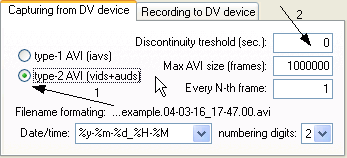In the following screen-shot from WinDV (source: Afonic DVD-Guides.com) it shows Type 1 as AVI (iavs) and Type 2 as AVI (vids + auds). Is this standard? Is Type 2 in NeroVisionExpress the same as Type 2 in any other capturing program?
Why would someone use Type 1?
What is (iavs)?

+ Reply to Thread
Results 1 to 8 of 8
-
-
here is the basic def of Type 1 and Type2
http://msdn.microsoft.com/library/default.asp?url=/library/en-us/directshow/htm/type1v...pe2dvfiles.asp
Type 1 is used for most efficient transmission.
Type 2 splits off the audio for faster processing during editing.
Type 2 is used by most editing programs. -
The article states:Originally Posted by edDV
For video capture, where maximum throughput is crucial, it is better to use a type-1 file, because type-2 files carry redundant audio data. (The video stream still has the audio data. The audio is simply hidden by labeling the stream as video.) Also, writing a type-2 file requires some additional processor time to split the interleaved stream.
What is a situation where maximum throughput is crucial? Videowork being done in a big hollywood studio? Videowork intended for professional release? -
When your HD can't keep up would be one. High quality DV-AVI and low quality DV-AVI require the same amount of bandwidth, but type1 requires slightly more than type 1 because of the additional audio track.Originally Posted by clothesburner626
-
How should this sentence read:Originally Posted by thecoalman
but type1 requires slightly more than type 1 because of the additional audio track
I can't tell what you're trying to say.
-
Originally Posted by clothesburner626
What that doesn't make sense?
Should read:but type2 requires slightly more than type 1 because of the additional audio track
Similar Threads
-
Convert DV type 2 to type 1? Or is there an app that will correct sync?
By Colmino in forum Newbie / General discussionsReplies: 7Last Post: 20th Dec 2022, 22:24 -
How to convert a trp type file to Mpeg2 type?
By Jemes-bs in forum Video ConversionReplies: 2Last Post: 13th Oct 2010, 16:59 -
type 1 or type 2 capture-newbie
By sar in forum Capturing and VCRReplies: 6Last Post: 28th Jul 2008, 19:22 -
DV AVI Type 2 -> Type 1 converter?
By alx3d in forum EditingReplies: 3Last Post: 29th Dec 2007, 21:16 -
Convert Type 2 DV to Type 1 (DVdate?)
By nlec in forum Video ConversionReplies: 30Last Post: 30th May 2007, 14:52




 Quote
Quote